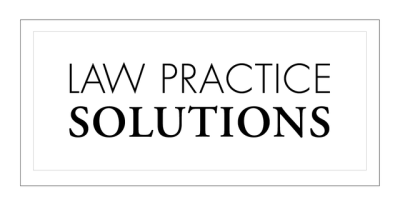
The best way to think about the difference between Microsoft Outlook and law practice management software is the old expression, “Jack of all trades and master of none.”
Microsoft created Outlook to be general enough that anyone can use it. It’s likely that your doctor, your accountant, and the owner of your favorite restaurant all use Outlook. It is the jack of all trades.
Conversely, law practice management software focuses on one type of user: attorneys. Every feature is designed with law firms in mind. That difference can save you time, make organizing your practice easier, and help you capture more of your billable time. Here are some key differences:
BUSINESS CARD VS. CLIENT FILE
Contacts in Outlook are designed to keep track of basic personal information like the information on a business card. In contrast, law practice management software is designed to track entire client files, not just contact information.
What does that mean? Out of the box, Outlook is ready to track information like nicknames, birthdays, and spouses. Law practice management software, on the other hand, has matter and client files that are ready to organize information like jurisdiction, area of practice, documents related to a matter, meeting notes, research, and email.
CONFLICT OF INTEREST SEARCH
Outlook can search your computer for emails, appointments, and contact information for signs of a conflict. Law practice management software can search the records of everyone in your firm for emails, appointments, contacts, meeting notes, details in fee and cost entries, research, and other client file information. Your conflict search can include the entire office — no matter who is out of the office that day — and it only takes a few seconds.
TRACKING TIME
Besides being designed specifically for law firms, law practice management software is also designed to typically work seamlessly with time and billing software applications. That means you can easily turn your appointments, emails, research, and time spent writing documents into billing entries. Tracking your time is much more efficient when you can convert any appointment on your calendar into billable time.
DOCUMENT ASSEMBLY
Outlook and Microsoft Word integrate through mail merge functionality which lets you insert fields from a contact into a standard letter, but your options are limited to the standard fields tracked in Outlook (e.g., name, address, etc.). With law practice management software, you can do the same thing and much more with document assembly functionality.
Law practice management software allows you to insert any information into a document from a matter file (e.g., insurance carrier, opposing counsel, etc.). The document assembly process can also automatically create a billing entry for the time you spend working on a document. It can automatically schedule a follow-up task for a specified number of days after you create the document; for example, it can alert you to follow up with opposing counsel regarding a letter you are sending them. You can even have the document assembly process prompt you to fill in a few blanks for information that you may not have in the law practice management software matter file, such as the date a document was signed.
SHARING INFORMATION
Law practice management software makes it easier to work with a team of people within your law firm. You can view appointments for members of your team to check when someone is free for a meeting. When you pull up a client file, you can see all the matter information including every email anyone has sent or received regarding the case along with all the associated documents, research, and notes. This helps save time you would otherwise spend keeping track of the work other people in the office have (or have not) done.
CHAIN OF EVENTS AND COURT RULES
Outlook lets you create recurring events. For example, you can schedule a regular staff meeting for 9 a.m. every Tuesday. Law practice management software can do that as well, but it can also automatically create a series of appointments and tasks that you can reuse. This feature can be helpful if there are a series of things you need to do every time you open a new case file. It can also help with tracking court rules or tasks you need to complete prior to a trial. Items in a calendar plan can be created and scheduled automatically based on a reference date like the date of a trial. Once created, each item appears on your calendar or task list based on the timeline calculated from the trial date. If the reference date changes, law practice management software can automatically recalculate and adjust the related dates accordingly.
COST TO CUSTOMIZE
You can get around some of Microsoft Outlook’s limitations through customization which can be expensive. But for law firms, Outlook cannot approach the level of usefulness that law practice management software can offer. Do not try to stuff your client file into a Rolodex. If you want software that helps you manage your practice, you should use practice management software designed specifically for attorneys.